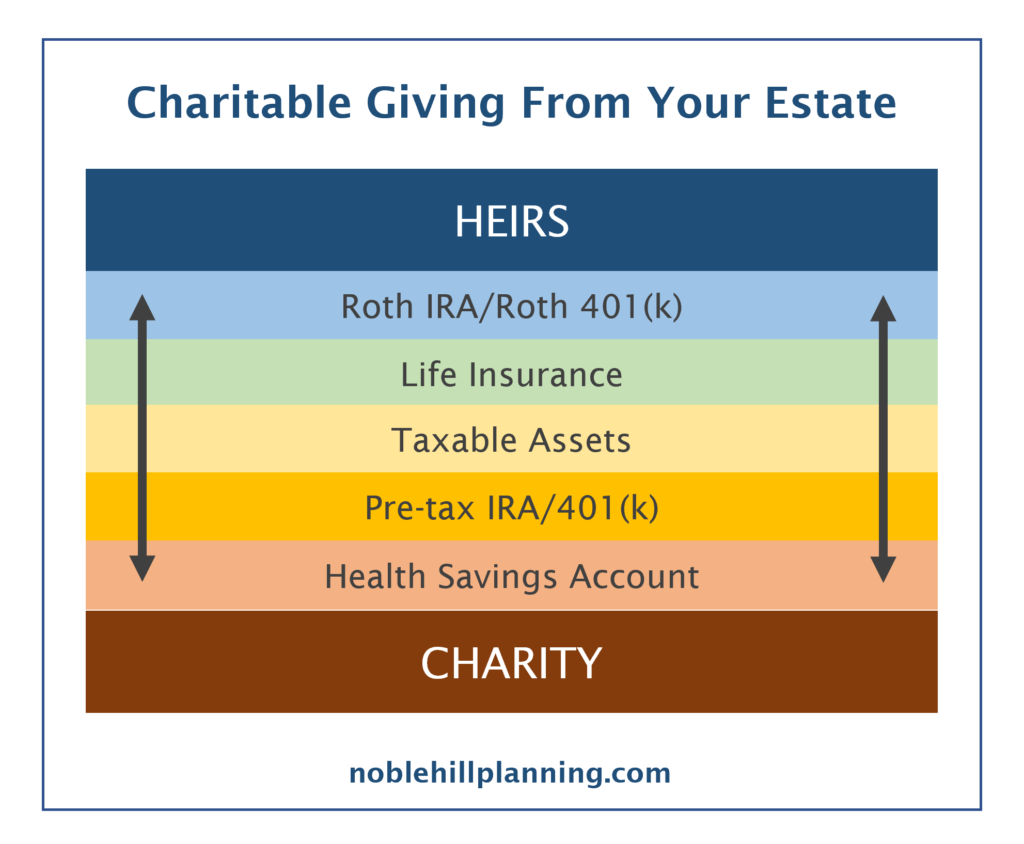Many people have charitable intentions, especially as they enter retirement and develop a better picture of their financial situation. But on many occasions, people don’t use the most efficient methods for giving assets to charity. Oftentimes it’s possible to make some modest adjustments to your giving strategy and realize benefits such as significant tax savings (which benefits both you and the charity), more convenience, and less junk mail clogging your mailbox.
Let’s start by looking at the main methods for charitable giving:
#1 – Cash donations
Cash is often the go-to choice for most people when it comes to charitable donations. It’s pretty straightforward. You give the charity cash, write a check, or put in your credit card information into the charity’s website. The charity provides you with a tax receipt, and at tax time, you input a tax deduction on your tax return (subject to various tax rules).
#2 – Donations of capital assets
Instead of cash, it’s often possible to donate capital assets such as appreciated stocks, ownership of private businesses or real estate to your favorite charity. If you invested in Google 20 years ago and have a lot of unrealized capital gains, you can give some of those shares to a charity. Just as with cash, you get a tax deduction (again, subject to various tax rules). You also can avoid paying any taxes on the unrealized capital gains associated with the donated asset.
#3 – Qualified charitable distributions
Qualified charitable contribution (QCD) also offer a good way to give to charity. However, the QCD method has a slew of rules that you need to follow:
- Must be at least 70.5 years old at the time you request the QCD
- $100,000 per year limit
- Funds must be transferred directly to the charity
- Funds must come from a pre-tax IRA such as traditional, rollover, or inherited
- SEP and SIMPLE IRAs are ok if not actively making contributions
- Not allowed from retirement plans such as 401(k) or 403(b)
One great thing about QCDs is that they can reduce the amount of your required minimum distribution (RMD). If you have an IRA and need to take $50,000 out under RMD rules, you could give that whole amount to charity as a QCD, and voila! no more RMD.
QCD logistics
Please don’t let the QCD rules scare you. Most custodians make it easy to execute a QCD using a simple form. Basically, you tell your custodian the name/address of your intended charity and they mail out a check. You’ll want to confirm that your charity receives that check.
However, there is one vital thing to remember with QCDs… do not forget to tell your tax preparer about them! Custodians such as Schwab, Fidelity, etc. aren’t responsible for tracking the tax status of QCDs. When they generate your 1099 tax form in January, you won’t see any mention of the QCD and neither will your tax preparer. And if your tax preparer doesn’t know about it, then most likely they will take the 1099 and input the amounts on the form into their tax software and BOOM! you will end up paying taxes on the QCD. To fix it, you’ll need to 1) catch the mistake and 2) amend your tax return. Not fun.
Other things to consider
Now that we’ve covered the basic methods for giving to charity, let’s take a look at how to approach an optimal charitable giving strategy. Please note that everyone has a unique situation, so it’s important to discuss these strategies with both your financial advisor and tax advisor before making a decision.
Start with the QCD
If you are eligible to do a QCD, then that’s likely your best starting point. As I mentioned before, QCDs count as part of your RMD, which is great. They also don’t increase the adjusted gross income (AGI) on your tax return, so they won’t bump you into a higher Medicare premium bracket (i.e. IRMAA surcharges).
Appreciated securities before cash
If you have the choice between giving cash or appreciated securities, you will likely get the most benefit from giving appreciated securities. The main drawback of giving appreciated securities is the IRS limits the amount of your potential tax deduction to 30% of your AGI (vs. 60% for most cash donations). If you make a big donation in relation to your AGI, you could be forced to carry forward more of the associated tax deduction when giving appreciated securities.
Consider using a donor advised fund
Many people should also explore the benefits of giving directly to their chosen charity vs using a donor advised fund (DAF). For those who don’t know, a DAF is a special vehicle for assisting with charitable donations. a DAF is actually a charity itself, just one that generally acts as a go between or middleman.
Here are the main benefits of using a DAF:
- Give to multiple charities from one website, get one consolidated tax receipt
- Anonymity and no ongoing solicitations (shielded by the DAF)
- Give now, pay out later
- Assistance when giving to small, unsophisticated charities
And here are the drawbacks of a DAF:
- The DAF doesn’t have to do what you tell them (very unlikely)
- DAFs (and their donors) have a reputation for “hoarding” charitable dollars
- Some DAFs have high minimums for account values and gifting amounts
- Relatively high fees for investment services
Many people could benefit from using a DAF if only for the consolidated tax receipt and shield from solicitations. For example, it can be a real pain scrambling around each year at tax time trying to find all your donation receipts. And sometimes when you give to a charity, they will send you years of spam mail/email asking for more donations. Many years ago I gave $25 to a well known charity. They spent the next 10 years mailing me fancy brochures and solicitations for more gifts. In the end, I gave $25 for the privilege of getting a bunch of junk mail. Better to let the DAF run interference.
I’ve also encountered an example where a DAF provided a better method for giving to a small charity. The client (we’ll call her Jane) wanted to give funds to two small churches in her community, but neither church was set up to accept donations of appreciated securities (this is fairly common for many small charities). Instead, Jane gave her appreciated shares to a DAF and asked the DAF to send the churches a check. In the end, the DAF provided Jane with a reliable conduit for making donations to her preferred organizations.
Much of the focus on DAFs is on the mega custodians such as Schwab Charitable, Fidelity Charitable, or Vanguard Charitable. But don’t be afraid to shop around as there are plenty of other great DAFs available. Check out every.org or charityvest.org. Or you can look up your local community foundation, many of which offer DAF services.
Stacking donations
One strategy that doesn’t get used enough is donation stacking. Nowadays, the vast majority of people do not itemize on their tax returns. As a result, many charitable donations provide zero marginal tax benefit to the donor. For example, if you give $5,000 per year to charity and have no other deductions, then you’ll just use the standard deduction and lose the benefit of the charitable deduction.
But what if you stacked 2, 3, 4, or 5 years of donations into a single tax year? Well, then you might stand a chance of getting your total itemized deductions above the standard deduction. At that point, you would gain a marginal tax benefit from your donations.
And using a DAF can help in this instance. You can give 5 years worth of donations to a DAF in a single tax year, but then instruct the DAF to pay out 1/5th of the donation each year for the next 5 years. You can also work with the DAF to invest the funds that are earmarked for future years.
This is where the reputation for “hoarding” donations comes from. Many donors give funds to a DAF, and then leave the funds sitting in the DAF for extended periods of time. As a result, assets held by major DAFs have ballooned in recent years. However, the overall payout rate for DAF assets is between 20-25% per year, which implies a 4-5 year payout timeline for most assets. I’m not sure the “hoarding” reputation is justified.
Stacking donations can also be useful if you anticipate a reduced income in the near future. Dumping a large amount of funds into a DAF, and using the associated tax deduction to offset your current (i.e. higher) income will leave you in a better position than spreading donations out over a period of time.
What about when I die?
Another area to consider is charitable giving from your estate. Many people set aside a portion of their estate for charitable giving. However, the strategy for giving from your estate can make a big difference to the end result.
We all know that certain accounts have different tax treatments. Pre-tax IRAs and Roth IRAs both have uses for tax planning. But if you are going to leave an IRA to a charity, best to make it the pre-tax variety. For example, you don’t want to leave a Roth IRA to charity as any funds coming out of the Roth IRA are tax free. Better to leave your Roth IRA to your kids and your pre-tax IRA to charity. The charity won’t pay taxes on any of the funds in the pre-tax IRA and your kids won’t pay any taxes on the funds in the Roth IRA.
Here is a chart showing which accounts are better to leave to heirs vs charities (or to spend on your own):

Some people may look at the chart and say, “Why on earth would I leave my health savings account to charity? It’s just like a Roth IRA.” That’s partially true. Much like a Roth IRA, you don’t pay taxes on funds pulled from an HSA. However, only a spouse is able to continue the tax shield of an HSA. Once both partners are gone, the HSA becomes immediately taxable.
Planning for what to do with your estate can get very complicated, especially if you have estate tax exposure. Don’t hesitate to consult with an estate planning attorney to help nail down all the finer details.

